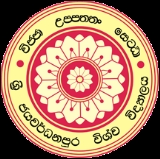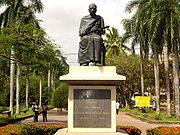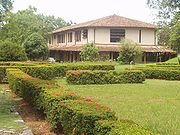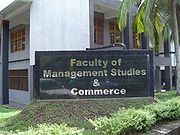
University of Sri Jayewardenepura
Encyclopedia

Nugegoda
Nugegoda is one of the most densely populated suburbs of Colombo. It is in the border of Sri Jayawardenapura Municipal Council Limits and Dehiwela Mt. Lavinia Municipal Council Limits, just outside Colombo City Limits. Central Nugegoda is a collection of densely packed shops and mixed residential...
, near Sri Jayewardenepura Kotte, the capital city of Sri Lanka. It was formed in 1958 out of the Vidyodaya Pirivena
Vidyodaya Pirivena
The Vidyodaya Pirivena was one of the prominent piriven in Sri Lanka.-Name:...
, a Buddhist educational centre.
History
The University of Sri Jayewardenepura dates back to 1873, when the Ven. Hikkaduwe Sri Sumangala Nayaka Thero laid the foundation stone for the university as a pirivenaPirivena
Pirivena is a monastic college for the education of Buddhist priests in Sri Lanka. These have been the centers of secondary and higher education in ancient times for lay people as well. Today 561 Piriven are founded and maintained by the Ministry of Education...
(Institute of Buddhist and Oriental Studies) named Vidyodaya (meaning "awakening of knowledge"). It was built on land at Maligakanda, a Colombo
Colombo
Colombo is the largest city of Sri Lanka. It is located on the west coast of the island and adjacent to Sri Jayawardenapura Kotte, the capital of Sri Lanka. Colombo is often referred to as the capital of the country, since Sri Jayawardenapura Kotte is a satellite city of Colombo...
suburb, with funds gifted by Andiris Perera Dharmagunawardhana
Andiris Perera Dharmagunawardhana
Muhandiram Lansage Andiris Perera Dharmagunawardhana was a Sri Lankan businessman, a philanthropist and a pioneer of the Buddhist revival movement...
. Mohottiwatte Gunananda, who was a great force in the emergence of this pirivena, intended to train educated orator monks to save Buddhism and for that purpose he made logic compulsory in pirivena education. The Pirivena taught Buddhist studies as well as pseudo-sciences like Astrology, widely accepted and held in high esteem in taditional society. However, the transition from Pirivena to University gradually converted it to a secular center of learning.
The University Act and the New University
In 1956, following a change of government with Solomon Dias BandaranaikeSolomon Dias Bandaranaike
Sir Solomon Dias Abeywickrema Jayatilleke Senewiratna Rajakumaruna Kadukeralu Bandaranaike, KCMG, Maha Mudaliyar, JP was the chief native representative, interpreter and adviser to the Governor of Ceylon by appointment as Head Mudaliyar and therefore was one of the most powerful personalities in...
as the Prime Minister and following the policy of promoting national languages and culture, it was decided to establish two new universities by conferring university status on the Vidyodaya and Vidyalankara Pirivenas. Accordingly, the Vidyodaya University and Vidyalankara University Act No 45 of 1958 established the two universities at the Vidyodyaya Pirivena at Maligakanda and the Vidyalankara Pirivena at Kelaniya. In 1958, it was reconstituted as the Vidyodaya University of Ceylon.
Welivitiye Soratha Maha Thero, who was the Principal of the Vidyodaya Pirivena, was appointed the first Vice-Chancellor of the Vidyodaya University. The university was ceremonially opened on 16 February 1959. Sir Oliver Goonatilleke, the Governor-General and ex-officio Chancellor of the University, expressed the aims and objectives of the new university:
The University commenced its academic activities with five faculties: Buddhist Studies, Philosophy, Languages, Arts, and Ayurveda and Science. There were twenty-two Departments of Study. Some of the students of the Vidyodaya Pirivena were among the first students of the university. Adult candidates with the requisite minimum entry requirements were also selected for admission. Admission was restricted to males and the initial student population was composed mainly of bhikkus (Buddhist Monks). The initial academic staff were drawn from the same Pirivena, or those who had been its outstanding alumni, and were mainly Scholarly Buddhist monks. Pandit Wickramarachchi, a famous Ayurveda
Ayurveda
Ayurveda or ayurvedic medicine is a system of traditional medicine native to India and a form of alternative medicine. In Sanskrit, words , meaning "longevity", and , meaning "knowledge" or "science". The earliest literature on Indian medical practice appeared during the Vedic period in India,...
physician was in charge of the minuscule department of science. These more secular subjects required the services of visiting lay staff.
New Campus
In 1961, a new location was selected at Gangodawila, 15 kilometres (9.3 mi) south east from the center of Colombo, and within walking distance of a main trunk road known as the High Level Road. This road connects ColomboColombo
Colombo is the largest city of Sri Lanka. It is located on the west coast of the island and adjacent to Sri Jayawardenapura Kotte, the capital of Sri Lanka. Colombo is often referred to as the capital of the country, since Sri Jayawardenapura Kotte is a satellite city of Colombo...
to Ratnapura
Ratnapura
- Floods :The town of Ratnapura is situated in the flooding plain of the river Kalu. The town experiences regular floods usually in the month of May. There is no large dam across the Kalu, so this leaves the city at the mercy of nature's forces every year. Several proposals have been made to reduce...
and beyond. Part of these lands belonged to the nearby Sunethradevi Pirivena, associated with King Parakramabahu VI (1412 - 1467). The shift of the university to the new site was effected on 22 November 1961, under the direction of Sri Soratha Thera. The Vice-chancellor invited the Department of the Government Archives to establish its archives within the campus, close to the University Libraray, to encourage research.
The Higher Education Act No 20 of 1966 brought far reaching changes to the university scene in Sri Lanka. As a result, admission to both those universities was opened to female students as well. The post of Vice-Chancellor would no longer be restricted to the Sangha, and all academic and administrative appointees had to satisfy criteria determined by the newly created National Council of Higher Education. This modernization process also resulted in the restructuring of some of the Faculties and Departments of Study, as well as of programmes of study. During the period when Walpola Rahula
Walpola Rahula
The venerable Prof Walpola Sri Rahula Maha Thera was a Buddhist monk, scholar and writer. He is considered to be one of the top Sri Lankan intellectuals of the 20th century. In 1964, he became the Professor of History and Religions at Northwestern University, thus becoming the first bhikkhu to...
was the Vice-Chancellor, the University grew significantly in stature. When Rahula left the University in 1969, linguist D. E. Hettiarachchi took over. A noted employee of the University at this time was Mahinda Rajapaksa
Mahinda Rajapaksa
Percy Mahendra "Mahinda" Rajapaksa ; ; born November 18, 1945) is the 6th and current President of Sri Lanka and Commander in Chief of the Sri Lankan Armed Forces. A lawyer by profession, Rajapaksa was first elected to the Parliament of Sri Lanka in 1970, and served as prime minister from April 6,...
, who was chairman of the United Corporations and Mercantile Union
United Corporations and Mercantile Union
The United Corporations and Mercantile Union is a Sri Lankan trade union which brings together workers in the public sector.The UCMU was founded in 1968. Dr N.M. Perera became its President and Anil Moonesinghe became its General Secretary. Moonesinghe travelled the country from factory to...
local on the campus. He later went on to be President of Sri Lanka
President of Sri Lanka
The President of Democratic Socialist Republic of Sri Lanka is the elected head of state and the head of government. The President is a dominant political figure in Sri Lanka. The office was created in 1978 but has grown so powerful there have been calls to restrict or even eliminate its power...
.
Insurgency and merger
Following the insurgency of 1971, the university premises were taken over by the army, and converted into a detention camp for suspected insurgents since many undergraduates had links with the insurgency. During this temporary occupation (1971-1972) the university functioned from temporary locations in Colombo, maintaining the basic academic and administrative services. Ellawala and V. K. SamaranayakeV. K. Samaranayake
Vidya Jyothi V. K. Samaranayake MBCS, MCS, FNASSL, MIEEE pioneered computing & IT development industry and usage in Sri Lanka and thus considered as the "Father of Information Technology" in Sri Lanka. He was a Professor of Computer Science and former Dean of the Faculty of Science,...
were Vice Chancellors at that time.
In 1972, all universities were merged into one institution under the University of Ceylon Act No.1 that renamed all universities as campuses of a single University of Sri Lanka
University of Sri Lanka
The University of Sri Lanka was the only university in Sri Lanka from 1972 until 1978. It had several constituent campuses at various locations around Sri Lanka. The University of Ceylon Act No. 1 of 1972, replaced the University of Ceylon with the University of Sri Lanka. In 1978 it was separated...
. Vidyodaya University became Vidyodaya Campus headed by a Campus President, appointed by the Minister of Education. The first President of the Campus under this system was Chandre Dharmawardana.
The university programmes became more "job-oriented", and attempts were made to introduce course-unit systems and other methods of continuous assessment. The very first course in Development studies in Sri Lanka, leading to a degree (B. Dev.) was started at this time. Post graduate courses in Statistics, Food Science, Polymer Science and Optometry were offered. The departments of Geography, Economics, Public and Business management etc., were expanded.
Reestablishment and renaming
Following change in government in 1977, the Universities Act No 16 of 1978 returned the independent university status to the Campuses while assigning some of the coordinating functions to a new University Grants CommissionUniversity Grants Commission (Sri Lanka)
The University Grants Commission is the body responsible for funding most of the State Universities in Sri Lanka, and operates within the frame work of the Universities Act No. 16 of 1978, itself established in 1979. A public organization, established under the Parliament Act No 16 of 1978...
. Being close to the city of Sri Jayawardenapura Kotte, the reestablished university was renamed to the University of Sri Jayewardenepura.
Its full-time student population is over 8,500, enrolled in the faculties of Arts, Management Studies and Commerce, Applied Sciences, Medical Sciences, and Graduate Studies
Faculties


is Prof(Mrs.)S.Piyasiri
Faculty of Applied Sciences
The dean of the faculty is Prof. Sudantha Liyanage of the Department of Chemistry.Academic Departments
- Department of Physics
- Department of Mathematics
- Department of Statistics and Computer Science
- Department of Chemistry
- Department of Botany
- Department of Zoology
- Department of Forestry and Environmental Science
- Department of Food Science and Technology
Faculty of Humanities and Social Sciences
The dean of the faculty is Prof.P.Athukorala.
Academic Departments
- Department of Economics
- Department of Political Science
- Department of English
- Department of Geography
- Department of History and Archeology
- Department of Pali and Buddhist Studies
- Department of Languages and Cultural Studies
- Department of Sinhala and Mass Communication
- Department of Social Statistics
- Department of Sociology and Anthropology
Faculty of Management Studies and Commerce

Academic departments
- Department of Accounting
- Department of Business Administration
- Department of Business Economics
- Department of Commerce
- Department of Decision Sciences
- Department of Estate Management and Valuation
- Department of Finance
- Department of Human Resource Management
- Department of Information Technology
- Department of Marketing
- Department of Public Management
- Department of Enterpreneurship
Special units
- Information Technology Resource Centre (ITRC)
- Accounting Resource Centre (ARC)
- Small and Medium Enterprise Development Support Unit (SMEDSU)
Academic departments
- Anatomy
- Biochemistry
- Community Medicine
- Family Medicine
- Forensic Medicine
- Medical Education and Health Sciences
- Medicine
- Microbiology
- Obstetrics and Gynaecology
- Paediatrics
- Parasitology
- Pathology
- Pharmacology
- Physiology
- Psychiatry
- Surgery
The Department of Medical Education and Health Sciences (DME&HS) was established to improve and sustain the quality of the Learning/Teaching processes in the faculty and to conduct certificate, diploma of degree courses in Health Sciences. Although, Medical Education units are available in the university system, the DME&HS is the 'first and only one' department established under the university system to develop, implement and review activities related to improving the efficiency of Learning/Teaching related to both Medical and Health Sciences. Most remarkably, the DME&HS is successfully facilitating collaborative work in implementing medical and para-medical (Allied Health Sciences) programmes including Nursing, Pharmacy and Medical and laboratory Science degrees.
Postgraduate Institute of Management
The Postgraduate Institute of Management is a semi-autonomous body affiliated to the University. It promotes advanced education and professionalism in management in Sri Lanka through the provision of postgraduate instruction, training, research, and development in the various branches of management and administrative studies.Historically related institution
The Vidyalankara University was created at the same time as the Vidyodaya University. Today Vidyalankara University is known as the University of KelaniyaUniversity of Kelaniya
The University of Kelaniya is a state university of Sri Lanka. Situated just outside the municipal limits of Colombo, in the ancient and historic city of Kelaniya, the University has two major campuses, seven locations, six faculties and four institutions....
.
Ragging
The University of Sri Jayewardenepura is noted for a high level of raggingRagging in Sri Lanka
Ragging is a verbal, physical or psychological abuse on newcomers to educational institutions. It is similar to the American phenomenon known as hazing. Sri Lanka is said to be its worst affected country in the world.-History:...
in recent years with several major incidents grabbing national headlines. These include the killing of Samantha Vithanage
Samantha Vithanage
Ovitigala Vithanage Samantha aka Samantha Vithanage was a third year Management student of the University of Sri Jayewardenepura, Sri Lanka, pioneered an anti-ragging campaign, who was killed on 7 November 2002 while in a discussion to stop the brutal practice of ragging in the faculty...
, who pioneered an anti-ragging campaign, by pro-ragging JVP
Janatha Vimukthi Peramuna
The Janathā Vimukthi Peramuṇa is a Marxist-Leninist, Communist political party in Sri Lanka. The party was involved in two armed uprisings against the ruling governments in 1971 and 1987-89...
supporters and the resignation of Prof.
Professor
A professor is a scholarly teacher; the precise meaning of the term varies by country. Literally, professor derives from Latin as a "person who professes" being usually an expert in arts or sciences; a teacher of high rank...
Chandima Wijebandara, the vice chancellor of the University, in protest against the ragging.

